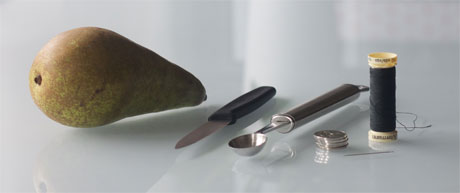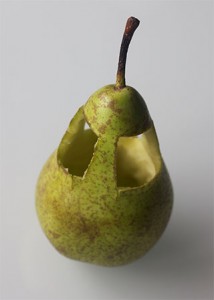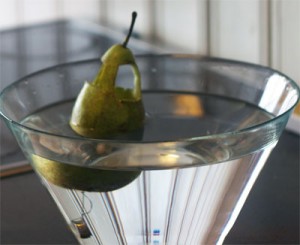My 3 year old daughter’s current favourite book is Jakob Martin Strid’s Den utrolige historien om den kjempestore pæra. In the story a giant pear is made hollow, and eventually turned into a boat. I decided to try and make a similar upright floating pear-boat out of a normal pear. One that my my daughter could play with once finished. Off I went to buy a pear and tools, the pear I ended up with have these specs:
- Weighs around 238 g.
- Displaces approximately 225 ml of water. This means it is slightly more dense then water since the weight of that water would be approximately 225 g.
- Judging from the pears available in the shop, the one I chose was slightly more symmetric then most pears.
In addition to the pear, the tools I used are shown in the image below:

The first step in pear pram creation, is to cut the windows using a knife. Once that is done carve out the inside using the melon baller. I recommend making the windows close to the top of the pear. If you make them too low they will result in water intake when launched. It is better to create the windows high initially and expand them downwards once you have a feeling for how the pear floats.

Another great reason for making the windows high up is lowering the center of mass. Pears have not yet been cultivated to float upright, and the center of mass is way too high for that. Having a too high center of mass on a ship is catastrophic. In its unmodified form a hollow pear will most likely perform worse then the Vasa on its maiden voyage.
To lower the center of mass even more, it is important to carve out as much as possible of the “roof”. Since the stalk extends into the pear this is difficult. It is easy to ruin the pear if you use too much force; be careful.
Even with the windows high up and a very light roof, the center of mass is still too high. Initially I added coins on the inside as ballast, this worked if I put the pear very carefully into the water, but it was still prone to capsizing.

To remedy this I moved the center of mass even lower by adding ballast on a thread below the pear. This was done by creating a knot on the thread and using a needle to get it through the bottom of the pear. Then the coins were added as shown in the picture. To ensure that water would not leak along the thread into the pear, I greased the entry points.
In its finished form the pear is quite stable, it could hold a surprising amount of Lego men without capsizing. I never got around to test adding a sail, but I think it might be stable enough to support a small sail.
Sadly rot is an inevitability facing all pear prams. If you have a great idea for prolonging pear pram life, please leave a comment.
